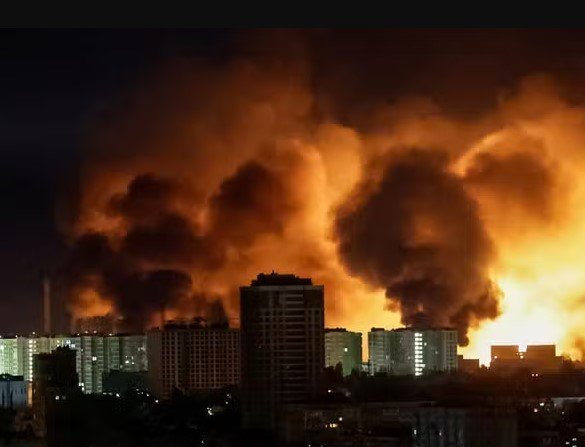A recent investigation shows that Iran’s missile strike in June 2025 targeted and hit a hidden underground bunker in Tel Aviv. This secret site, run by Israeli and US military forces, sat under a luxury apartment tower, sparking global concerns about military tactics in urban areas.
The strike happened on June 13 during a tense 12-day conflict between Iran and Israel. Iranian forces launched hundreds of ballistic missiles and drones, with some breaking through Israel’s defenses to strike key spots in the city.
Details of the June Strike
Iran fired nearly 400 missiles and hundreds of drones at Israel over several days in June 2025. Officials in Israel reported that about 35 missiles got past their Iron Dome system and caused damage in Tel Aviv and other areas.
The attack came after Israel hit Iranian nuclear sites, including Fordow and Natanz. Iran called it retaliation, aiming at military and intelligence targets to show its strength.

Videos from the scene showed explosions lighting up the night sky near central Tel Aviv. Local residents described hearing loud booms and feeling their buildings shake.
Eyewitness accounts painted a picture of chaos, with emergency services rushing to seal off streets. One resident said the blast felt like an earthquake, forcing families to seek shelter in basements.
Uncovering the Hidden Bunker
The bunker, known as Site 81, lies beneath the Da Vinci Towers, a high-end complex with apartments and offices. Built over a decade ago with help from US Army engineers, it serves as a command center for intelligence operations.
Public records and leaked documents point to its role in monitoring threats and coordinating responses. The site includes advanced tech for secure communications, shielded from electronic interference.
Satellite images of the area often appear blurred on popular mapping services, hinting at efforts to keep it secret. Nearby landmarks, like air force towers, helped experts pinpoint its exact location.
The bunker sits just meters from civilian spots, including a playground and community center. This setup has led to questions about safety in crowded cities.
Investigators used photos and emails to confirm the site’s ties to both US and Israeli forces. It reportedly houses units focused on cyber defense and signal intelligence.
Key Revelations from the Report
The investigation brings to light several important facts about Site 81 and the strike.
- Site 81 was expanded in 2013 into a 6,000-square-meter facility with US support.
- The Da Vinci Towers, built on a former ministry site, hide the bunker’s entrance.
- Iranian missiles caused a fire at the complex, but details on damage remain limited due to security restrictions.
- The site is linked to Israel’s Unit 8200, known for advanced tech operations.
These points highlight how military assets blend into urban life, raising ethical debates.
Timeline of the 2025 Conflict
The June events unfolded quickly, escalating tensions in the region. Here is a brief timeline of major moments:
| Date | Event Description |
|---|---|
| June 13 | Iran launches missile barrage on Tel Aviv, hitting Site 81 and other targets. |
| June 18 | Photos emerge showing damage from Iranian attacks across Israel. |
| June 19 | Israel vows retaliation after a missile strikes a hospital in the south. |
| June 20 | US announces strikes on three Iranian nuclear sites. |
| June 21 | Conflict ends with a fragile ceasefire amid international pressure. |
This table shows the rapid back-and-forth that defined the short war.
Global Reactions and Implications
World leaders reacted strongly to the revelations. The US denied direct involvement in the bunker’s daily operations but confirmed past construction aid. Officials stressed that the site supports joint defense efforts against regional threats.
Iran hailed the strike as a success, claiming it exposed Israel’s vulnerabilities. State media broadcast images of the attack, boosting national pride.
Experts warn that placing military sites under civilian buildings could violate international laws. Human rights groups argue it puts innocent people at risk, much like accusations leveled at other conflicts.
The event has strained US-Israel ties, with calls for more transparency. It also highlights Iran’s growing missile capabilities, which now reach farther and more accurately than before.
In the broader picture, this fits into ongoing Middle East tensions. Recent drone attacks and cyber incidents in 2025 have kept the region on edge, with fears of wider escalation.
What This Means for Future Security
The bunker hit raises big questions about urban warfare. Cities like Tel Aviv mix military and civilian spaces, making precise strikes harder without collateral damage.
Analysts predict more advanced defenses, like better anti-missile systems, in response. Iran’s ability to target hidden sites shows the need for stronger intelligence sharing among allies.
For residents, the strike has led to demands for better warnings and evacuations. Local governments are reviewing building codes near sensitive areas.
This incident also spotlights the role of technology in conflicts. With AI and satellites playing bigger parts, secrecy becomes tougher to maintain.
As details emerge, the world watches how Israel and Iran navigate the aftermath. Peace talks could gain traction if both sides see the costs of continued fighting.
What do you think about this revelation? Share your thoughts in the comments below and spread the word to keep the conversation going.
